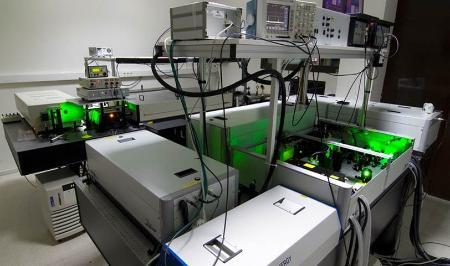CLPU
Investigations into particle acceleration towards hadron therapy
Trainee: Luca Christopher Stockhausen
Supervisor: Enrique Conejero

High power lasers interacting with solid targets generate plasmas which are able to sustain huge electric and magnetic field gradients. These fields are in turn able to accelerate particles to high energies in a very short distance. By carefully selecting the parameters of the interaction, it is possible to produce ultra-low emittance beams of protons and ions with energies up to tens of MeV in regions of less than one millimetre. Such laser-generated beams are a potentially cheaper and more compact alternative to conventional proton accelerators, and therefore have great potential for medical applications. Laser-produced proton beams may be employed to generate short-lived isotopes to be used as radiotracers in Positron Emission Tomography (PET), or directly to treat tumours by hadron therapy, which is currently applied in costly cyclotron facilities.
However, there are some important technical obstacles that need to be solved before these applications may be realised. The main challenges are attaining a high enough proton energy, monochromaticity, energy stability, and average flux.
The aim of this project is to identify adequate parameter sets, target geometries, and beam shaping and control schemes to obtain proton and ion beams which could be used for nuclear radiotracers at lower energies and therapy at higher energies.
Luca Stockhausen will first simulate the generation of particle beams by means of plasma codes before conducting experimental studies with CLPU's laser systems, as well as making experiments on proton acceleration at lower energies. Furthermore he will participate in collaborative experiments with leading research groups using international high power laser facilities.
Femtosecond X-ray sources from laser-driven electron accelerators
Trainee: Andreas Döpp
Supervisor: Enrique Conejero
Andreas Döpp will work on laser-driven electron acceleration and related femtosecond X-ray sources. Different targets and injection schemes will be evaluated using simulations in order to optimize either electron energy/charge or x-ray energy/brightness. On this basis the design for the first experiments on electron acceleration and x-ray emission with the VEGA facility at CLPU will be produced.
Andreas will also take part in experiments at partner institutes, in particular the Applied Optics Laboratory (LOA) in Paris where laser-accelerated electron beams will be used to create X-rays via the betatron process or Thomson/Compton backscattering at the new Salle Jaune facility. Furthermore it is envisaged that the first steps towards applications of these sources will be made, for example in phase contrast imaging.
Video:
Scientist in Charge:
Images courtesy of CLPU